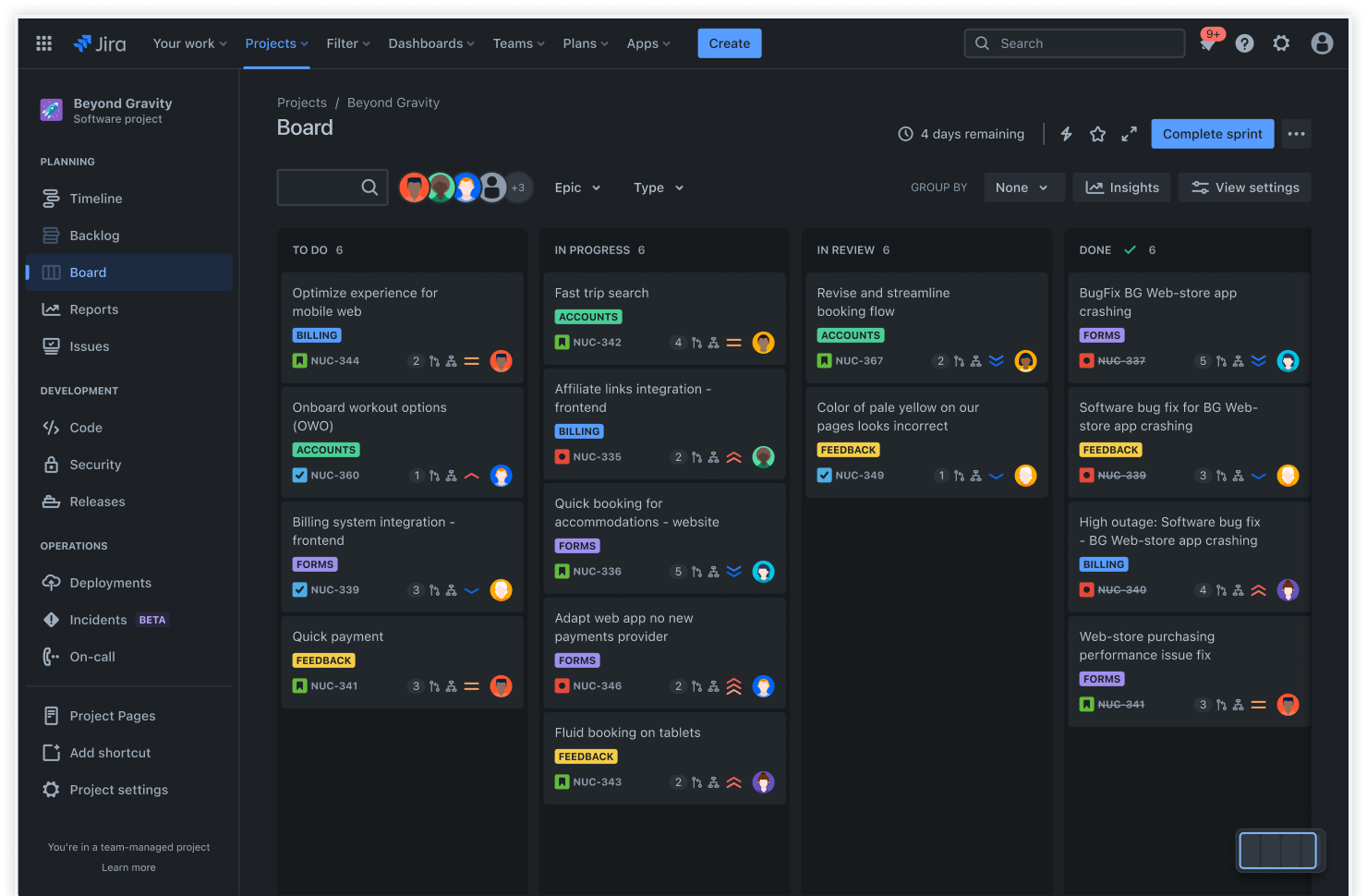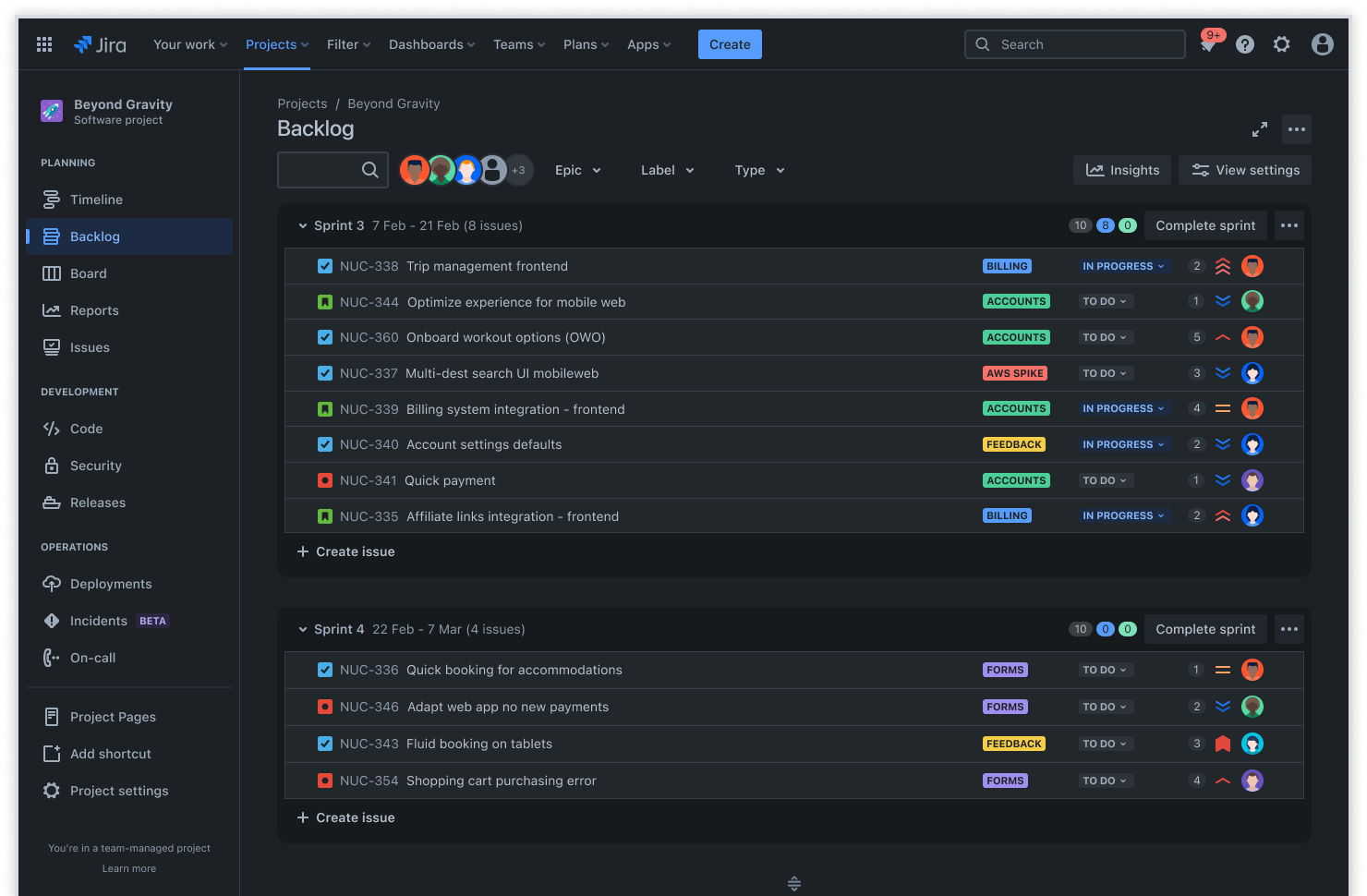Comprehending the distinction between product and sprint backlogs is crucial in agile project management and scrum methodologies. It directly affects project planning, project management efficiency, and project success. Misunderstanding the two can lead to unfocused teams, scope creep, goal misalignment, ineffective planning, and reduced transparency.
Project leaders can ensure their teams remain focused by clearly understanding product and sprint backlogs and their proper management, along with integrating Kanban practices. In doing so, teams can deliver incremental value while aligning with the overall product vision and strategic goals.
This guide will cover the differences between sprint vs. product backlogs, their roles in agile project management, best practices for managing sprint and product backlogs, and more.
What is a product backlog?
The product backlog is a dynamic, prioritized list of all the features, functions, requirements, enhancements, and fixes necessary for a project. It ensures that the agile team, including those in agile scrum roles, focuses on efficiently delivering the most value to the customer.
In agile methodology, the product backlog helps prioritize and organize project requirements and defines the project scope. Items in the product backlog are ranked based on their importance and urgency, and their organization involves breaking down large and complex projects into manageable tasks to tackle incrementally.
Example of a product backlog
In this example, the items’ positions in the list (from highest to lowest priority) are based on their business value and the urgency of stakeholder requirements.
High priority (must have)
These items are critical for the product’s success; teams must address them in upcoming sprints.
1. User login functionality: Allows users to log in to the application securely
- Business value: Essential for user authentication and personalization
- Stakeholder: Product owner
2. E-commerce platform checkout process: Helps users purchase items in their cart
- Business value: Directly affects revenue generation
- Stakeholder: Business development manager
Medium priority (should have)
These items improve the product but are less critical than high-priority items.
1. Product recommendation engine: Suggests products based on user behavior and preferences
- Business value: Increases average order value through personalized recommendations
- Stakeholder: Marketing manager
2. User profile customization: Allows users to customize their profile settings
- Business value: Improves user satisfaction and engagement
- Stakeholder: Community manager
Low priority (could have)
These items are “nice to have,” and you should include them if you have enough time and resources after you address higher-priority items.
1. Social media integration: Lets users share products on their social media accounts
- Business value: Increases product visibility and potential user acquisition
- Stakeholder: Social media specialist
2. Dark mode user interface (UI) option: Provides a dark theme option for the user interface
- Business value: Offers an alternative visual experience for users
- Stakeholder: UI designer
Technical debt and bug fixes
These items address technical improvements and fixes for maintaining the product’s health and performance.
1. Database optimization: Improves queries for faster load times
- Business value: Enhances application performance and user satisfaction
- Stakeholder: Database administrator
2. Fix checkout bug on mobile devices: Resolves a bug preventing checkout on portable appliances.
- Business value: Ensures all users can complete purchases
- Stakeholder: Quality assurance (QA) lead
What is a sprint backlog?

The sprint backlog is a curated list of items the development team commits to completing during a sprint. Its primary purpose is to break down the selected product backlog items into actionable tasks and provide a clear sprint plan. A sprint is a time-boxed iteration of work, and the items are typically user stories or tasks.
The sprint backlog starts with a sprint planning meeting, where the team selects tasks from the product backlog. The team refines and updates the backlog as work progresses. During the daily standup meeting, team members discuss their progress and impediments to their tasks, which helps keep the backlog updated and ensures the team remains on track to achieve the sprint’s objectives.
Example of a sprint backlog
Selected product backlog items for the sprint include the following:
- Redesign the checkout page: Streamline the process and reduce cart abandonment rates.
- Implement a product recommendation algorithm: Personalize product suggestions based on user browsing history.
- Optimize mobile responsiveness: Ensure the e-commerce platform is fully functional on portable appliances.
- Bug fix the payment gateway timeout: Address a critical issue where users experience timeouts during the payment process.
Breaking down sprint backlog items:
This process involves breaking down each selected product backlog item into smaller actionable tasks before estimating and assigning them to team members based on their capacity and expertise.
1. Redesign the checkout page
- Task 1.1: Conduct user research to identify pain points (Assigned: User experience researcher, eight hours)
- Task 1.2: Create wireframes (Assigned: UI designer, 16 hours)
- Task 1.3: Develop frontend code (Assigned: Frontend developer, 24 hours)
- Task 1.4: Integrate with backend (Assigned: Backend developer, 16 hours)
- Task 1.5: Conduct usability testing (Assigned: QA engineer, eight hours)
2. Implement product recommendation algorithm
- Task 2.1: Analyze user browsing data (Assigned: Data scientist, 12 hours)
- Task 2.2: Develop recommendation algorithm (Assigned: Backend developer, 20 hours)
- Task 2.3: Integrate algorithm with product pages (Assigned: Frontend developer, 12 hours)
- Task 2.4: Test algorithm accuracy (Assigned: QA engineer, eight hours)
3. Optimize mobile responsiveness
- Task 3.1: Identify current mobile responsiveness issues (Assigned: Frontend developer, eight hours)
- Task 3.2: Adjust Cascading Style Sheets for mobile screens (Assigned: Frontend developer, 16 hours)
- Task 3.3: Test on various devices and browsers (Assigned: QA engineer, 12 hours)
4. Bug fix: payment gateway timeout
- Task 4.1: Reproduce the timeout issue (Assigned: Backend developer, four hours)
- Task 4.2: Identify the root cause (Assigned: Backend developer, eight hours)
- Task 4.3: Implement a fix (Assigned: Backend developer, 12 hours)
- Task 4.4: Test payment process (Assigned: QA engineer, eight hours)
Key differences between sprint backlog vs. product backlog
Sprint and product backlogs serve distinct purposes, and the approach to managing them differs throughout the development process. Let’s explore the differences between product vs. sprint backlog, focusing on their scope and purpose, ownership and responsibility, level of detail, and flexibility.
Scope and purpose
The product backlog encompasses the entire project scope. It serves as a long-term, prioritized list of all features, enhancements, and fixes necessary for the product.
In contrast, the sprint backlog is a subset of the product backlog. It focuses on the tasks and goals necessary to complete within a single sprint and provides a detailed, short-term plan for achieving the sprint’s objectives.
Ownership and responsibility
The product owner owns and manages the product backlog. They prioritize tasks within it and ensure it aligns with user needs and business goals.
The development team owns the sprint backlog and handles the task breakdown and execution.
The scrum master provides process oversight and facilitates agile workflows and practices.
Level of detail
The level of detail in the sprint backlog is more granular than in the product backlog, as the former contains detailed tasks for implementing the higher-level user stories or features outlined in the latter.
Flexibility
The product backlog is dynamic and subject to continuous refinement and reprioritization based on evolving project needs and stakeholder feedback.
In contrast, the sprint backlog remains fixed for the sprint to allow the team to focus on completing the committed work without disruptions.
The relationship between sprint and product backlogs
Sprint and product backlogs interconnect through the sprint planning process. Items are selected from the product backlog to populate the sprint backlog.
Conversely, during sprint reviews, feedback and insights that the team gains during sprint execution may lead to updates in the product backlog. This process ensures that both backlogs evolve in response to each other and remain aligned with the project’s changing requirements and priorities.
Best practices for managing sprint and product backlogs
Best practices for managing sprint and product backlogs include employing prioritization techniques, such as Weighted Shortest Job First (WSJF) and MoSCoW, fostering open communication among team members and stakeholders, and refining the product backlog to ensure it remains relevant and aligned with project goals.
WSJF sequences jobs by dividing the cost of delay by the job's duration or size so the most valuable work is completed first. MoSCoW categorizes project tasks into must-have, should-have, could-have, and won't-have categories to help stakeholders understand the importance of deliverables.
Jira supports these practices with features such as the following:
- Scrum boards are great for breaking down projects and managing work in sprints.
- Backlogs are suitable for organizing, estimating, and prioritizing issues.
- Timelines are great for visualizing epics, dependencies, and releases.
Streamline backlog management with Jira

There are fundamental differences between sprint and product backlogs. Understanding them is crucial for project management success.
Jira excels in backlog management. Its boards help teams visualize, track, and manage work efficiently from sprint to sprint, all in one place, improving productivity and project visibility.
Jira is also versatile. It supports various agile practices and project management methodologies so that teams can comprehensively plan tasks in the backlog, execute work in time-boxed sprints, and visually track progress on the board. With Jira, you get a clear understanding of the project’s scope and status at all times.
Product backlog vs. Sprint backlog: Frequently asked questions
How frequent are sprint backlog and product backlog updates?
Sprint backlog updates occur daily during the scrum to reflect the progress and necessary adjustments. Product backlogs undergo continuous refinement throughout the project’s lifecycle, with regular backlog grooming sessions to ensure they remain aligned with evolving project needs and stakeholder feedback.
What criteria can teams use to prioritize items in sprint and product backlogs?
The priority of items in sprint and product backlogs is based on criteria such as business value, dependencies, risk, and urgency, which you can determine using techniques such as MoSCoW and Weighted Shortest Job First. However, the specific criteria and prioritization methods may differ between the two to reflect their unique scopes and objectives.
How do sprint and product backlogs contribute to the overall success of agile projects?
Sprint and product backlogs contribute to the overall success of agile projects by ensuring the efficient prioritization and organization of tasks. Sprint backlogs facilitate focused, short-term goal achievement, while product backlogs guide the long-term project vision.